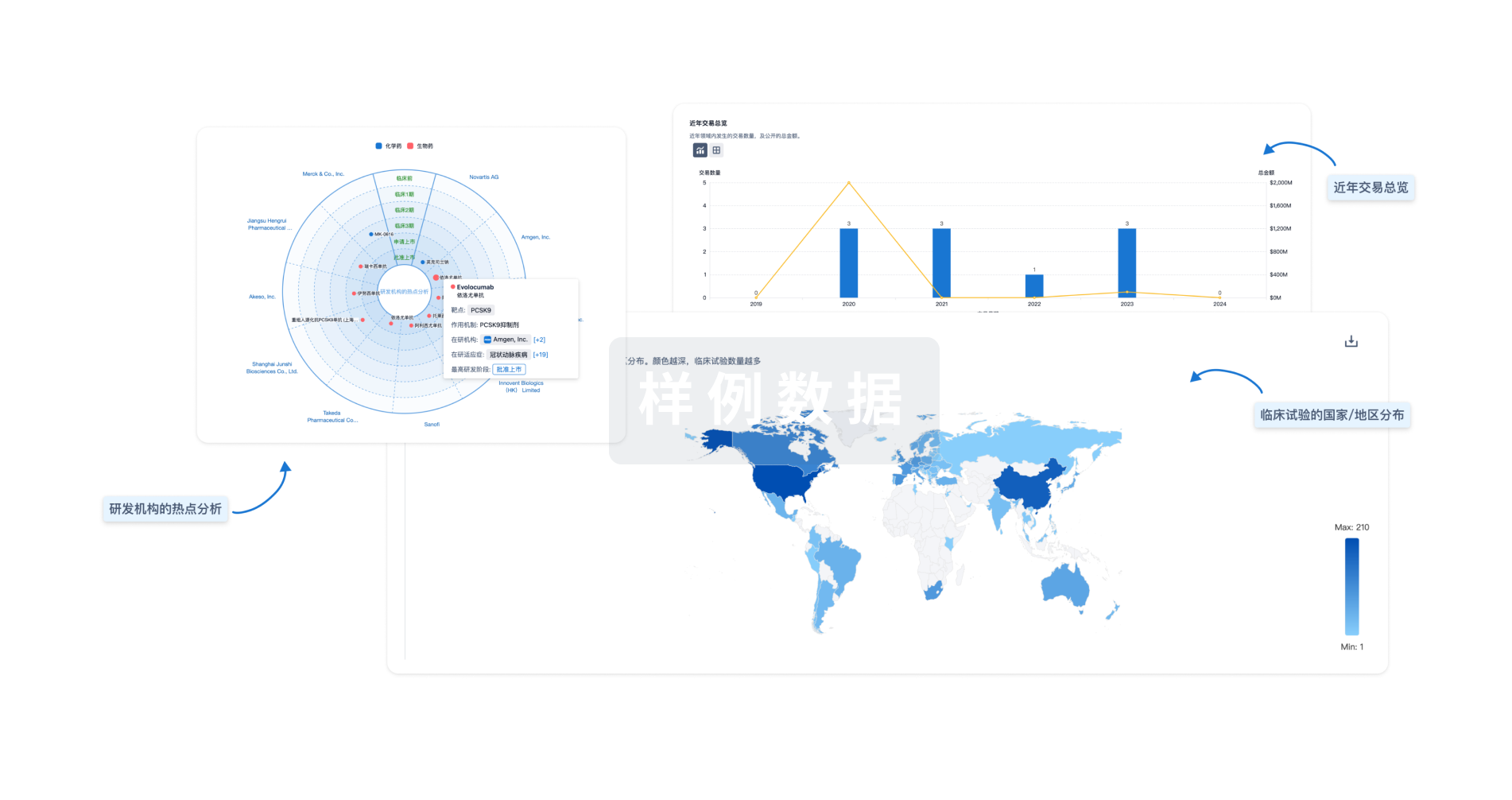预约演示
更新于:2025-05-07
PI4Ks
更新于:2025-05-07
基本信息
别名 1-phosphatidylinositol 4-kinase family、1-磷脂酰肌醇4-激酶 |
简介- |
关联
12
项与 PI4Ks 相关的药物靶点 |
作用机制 PI4Kβ抑制剂 |
在研机构 |
原研机构 |
最高研发阶段临床1期 |
首次获批国家/地区- |
首次获批日期1800-01-20 |
9
项与 PI4Ks 相关的临床试验NCT06597500
A Single-Centre, Open-Label, Single Sequence Study to Evaluate the Effect of Itraconazole on the Pharmacokinetics of Single Inhaled Doses of GSK3923868 in Healthy Participants
The purpose of this study is to evaluate how itraconazole affects the blood concentration of GSK3923868 in healthy adults.
开始日期2024-09-30 |
申办/合作机构 |
NCT06577597
A Phase 1, Randomized, Double-Blind, Placebo-Controlled, Parallel Group Study of the Safety, Tolerability and Pharmacokinetics of Single Doses of GSK3923868 Administered Via Dry Powder Inhaler to Healthy Participants of Chinese, Japanese and European Ancestry
This study is designed to understand how the drug GSK3923868 works in the bodies of healthy people from Japanese, Chinese, and European ancestries. This is important to meet the rules for including these groups in future worldwide studies. The study is carefully planned to reduce differences that might come from comparing results across different studies and locations, making it easier to compare results between these ethnic groups. The main goal is to check if GSK3923868 is safe and easy to tolerate when given as a single inhaled dose to healthy people from these three ancestries. The study also wants to see how the drug moves in the blood after a single inhaled dose in these groups. On the first day of the study, participants will be randomly chosen to receive either a single dose of GSK3923868 or a placebo. The aim is to have enough people take part so that 10 healthy people from each ancestry group (a total of 30 people) can successfully finish the study. Should a participant withdraw from the study before completion, the GSK Medical Monitor and the investigator may select a replacement. The replacement participant will be assigned the same treatment as the original participant.
开始日期2024-09-02 |
申办/合作机构 |
NCT05677347
A Randomized, Double-blind, Placebo Controlled, Single and Repeat Dose Study to Assess the Safety, Tolerability, and Pharmacokinetics of Inhaled GSK3923868 in Participants With Chronic Obstructive Pulmonary Disease (COPD)
This is a two parts study, a single ascending dose followed by 14-days repeat dosing. The single ascending dose part will assess two dose levels of GSK3923868 or placebo across two treatment periods 1 and 2 in a single cohort of participants with a washout period of a minimum of 5 days after each treatment periods. The repeat dose part will assess repeated one dose level of GSK3923868 or placebo in treatment period 3 with up to 14 days of follow up in the same cohort of participants. The duration of study participation for treatment period 1, 2 and 3 will be 6, 6 and up to 29 days (including follow up), respectively.
开始日期2023-01-23 |
申办/合作机构 |
100 项与 PI4Ks 相关的临床结果
登录后查看更多信息
100 项与 PI4Ks 相关的转化医学
登录后查看更多信息
0 项与 PI4Ks 相关的专利(医药)
登录后查看更多信息
602
项与 PI4Ks 相关的文献(医药)2025-12-01·Journal of Clinical Immunology
Biallelic PI4KA Mutations Disrupt B-Cell Metabolism and Cause B-Cell Lymphopenia and Hypogammaglobulinemia
Article
作者: L Stoddard, Jennifer ; Bugarin, Cristina ; Adams, David ; Mefford, Heather C ; Macnamara, Ellen ; Adam, Margaret P ; Rebellato, Stefano ; Lo, Bernice ; Holzinger, Dirk ; Roubertie, Agathe ; Barberis, Matteo ; Malighetti, Federica ; Cazzaniga, Gianni ; Emam Mousavi, Fatemeh ; Piazza, Rocco ; Borkhardt, Arndt ; O'Leary, Melanie ; Biondi, Andrea ; Barredo, Estibaliz ; Raspall-Chaure, Miquel ; Saettini, Francesco ; Chinello, Clizia ; Bhatia, Sanil ; Moratto, Daniele ; Michaud, Vincent ; Santamaria, Patricia VVelez ; Vockley, Catherine Walsh ; Elmi, Asha ; Uhlig, Holm H ; Brusco, Alfredo ; Crosby, Andrew H ; Mandrile, Giorgia ; Mauri, Mario ; Kuehn, Hye Sun ; Pujol, Aurora ; Amel, Hassan ; Gutiérrez-Solana, Luis González ; Salter, Claire G ; Planas-Serra, Laura ; Giuliani, Silvia ; Paglia, Giuseppe ; Fazio, Grazia ; Denti, Vanna ; Magni, Fulvio ; Guerra, Fabiola ; D'Souza, Precilla ; Nelson, Zoe ; Pavinato, Lisa ; Pagani, Lisa ; Savino, Angela Maria ; Deal, Christin ; Baple, Emma L ; Quadri, Manuel ; Martín-Nalda, Andrea ; Rosenzweig, Sergio D
2025-03-27·Journal of Medicinal Chemistry
Discovery of 5-Phenylthiazol-2-amine Derivatives as Novel PI4KIIIβ Inhibitors with Efficacious Antitumor Activity by Inhibiting the PI3K/AKT Axis
Article
作者: Ruan, Xiuqin ; Hao, Siyuan ; Zhou, Qingfa ; Jia, Shuolei ; Wang, Bichuan ; Wu, Tianzhi ; Han, Fang
2025-03-04·Cureus
The First Known Case Report of a Novel Homozygous Nonsense Variant in the OSBPL9 Gene Associated With Fetal Cerebral Ventriculomegaly, Cerebellar Hypoplasia, and Arthrogryposis Multiplex
Article
作者: Menon, Pramila G ; Vaniawala, Shalin ; Mithbawkar, Shilpa M ; Tamhankar, Vasundhara ; Tamhankar, Parag M ; Kachhadiya, Tushar
8
项与 PI4Ks 相关的新闻(医药)2025-04-09
·精准药物
2025年3月25日,中国科学院上海药物研究所陈小华课题组与谭敏佳、李佳课题组合作在Angew. Chem. Int. Ed.期刊发表题为“Cross-Linking Profiling of Molecular Glue Degrader-Induced E3 Ligase Interactome to Expand Target Space”的研究论文。团队基于基因密码子扩展技术、光交联非天然氨基酸和蛋白质组学分析,发展了一种在活细胞内直接捕捉“分子胶诱导的E3连接酶-底物”相互作用的新方法。该方法为分子胶降解剂及其可调控的靶标发现提供了新的化学生物学工具,为探索“难成药”靶标的降解和扩展靶标空间提供新视角。该论文被Angew. Chem. Int. Ed.期刊选为“Very Important Paper”。分子胶(Molecular Glue, MG)是一类通过诱导形成新的蛋白质-蛋白质相互作用(neoPPIs)来调控靶标蛋白功能的小分子化合物(图1a),已成为新药发现和疾病治疗新范式。发现分子胶诱导的底物,不仅对新分子胶降解剂的设计和发现具有重要科学意义,而且为扩展靶标空间提供新思路,从而发展疾病治疗新策略。分子胶诱导的泛素蛋白酶体系统的靶向蛋白降解涉及多个生物学过程,然而,现有研究方法主要依赖于底物降解终点或底物泛素化标记的检测,难以有效捕获分子胶诱导形成的E3连接酶与底物的动态相互作用,制约了其可调控底物包括可降解和非降解底物的系统性发现及其作用机制的深入研究。针对以上挑战,该研究提出了“光交联非天然氨基酸捕捉分子胶诱导的底物”的策略,开发了一种活细胞中分子胶诱导的底物发现新方法,实现了对分子胶诱导的E3连接酶底物及分子胶降解剂的发现(图1b)。本工作发展的活细胞内“光交联非天然氨基酸捕捉分子胶动态诱导的底物”新方法本研究基于基因密码子扩展技术,将具有光交联活性的非天然氨基酸(UAA)定点引入到E3连接酶CRBN的底物结合界面,光激活条件下实现活细胞内对分子胶诱导的CRBN-底物共价捕获。这一方法突破了现有技术在灵敏度和准确性上的限制,成功鉴定出分子胶CC-885诱导的内源性降解底物(如GSPT1、GSPT2、ETF1),并揭示了临床分子DKY709降解的新靶标FIZ1,拓展其潜在靶标空间。此外,基于分子胶与CRBN的结合特点,设计了两种新型分子胶降解剂CM-2和CM-3,这些分子胶在多发性骨髓瘤MM.1S细胞系中表现出显著的抗增殖活性;并利用该方法揭示了其诱导的新底物(如ZFP91,PI4KB等),为开发新一类分子胶及其可调控的靶标发现提供了新策略。同时,该研究发现了底物与CRBN结合的新模式,为“E3连接酶-分子胶-诱导底物”的识别机制提供了新见解。该项研究对分子胶发现的重要意义在于,更多不同结构类型分子胶底物互作组的系统性分析结果,能够为针对其中感兴趣的被招募底物的新分子胶设计提供源头信息,进而设计特异性分子胶降解该底物、扩展分子胶可调控的靶标空间。该方法不仅能够全面分析分子胶诱导的蛋白-蛋白相互作用,可扩展到更多分子胶诱导底物的发现,为新分子胶及其可调控靶标的发现提供了新策略;该方法还可拓展至更广泛的靶向蛋白降解(TPD)和化学分子诱导的蛋白质互作领域的研究,有助于推进针对"难成药"靶标的分子胶降解剂或蛋白质稳定剂的发现。上海药物所副研究员许亚莉、同济大学博士后赵雯思、上海药物所博士后聂辉军、助理工程师王家敏为本论文的共同第一作者。上海药物所陈小华研究员、谭敏佳研究员、李佳研究员为本论文的通讯作者。该工作得到国家自然科学基金委、上海市市科委扬帆项目和上海药物所自主部署项目等支持。全文链接https://onlinelibrary.wiley.com/doi/epdf/10.1002/anie.202505053声明:发表/转载本文仅仅是出于传播信息的需要,并不意味着代表本公众号观点或证实其内容的真实性。据此内容作出的任何判断,后果自负。若有侵权,告知必删!长按关注本公众号 粉丝群/投稿/授权/广告等请联系公众号助手 觉得本文好看,请点这里↓
蛋白降解靶向嵌合体
2025-03-25
·学术经纬
▎药明康德内容团队编辑(来源:清华大学)
细胞自噬是真核细胞中保守的降解性代谢通路,在维持细胞内稳态及生存起至关重要的作用,自噬的异常与诸多疾病的发生发展密切相关,例如癌症等。多年来,领域内的科学家一直在试图靶向自噬来治疗癌症。但目前尚未有特异性靶向自噬而治疗癌症的药物被成功开发,其重要原因是导致自噬失调的具体分子事件,特别是癌症相关自噬和生理性自噬(如饥饿诱导的自噬)之间的差异尚未阐明。
随着自噬在肿瘤发生发展过程中调控作用的研究,靶向自噬的肿瘤治疗逐渐变得重要,现在已经报道了通用靶向溶酶体(自噬)的药物氯喹作为肿瘤治疗的自噬通用药物,但是氯喹的非特异性会影响到很多生理过程,如会抑制机体基础自噬和机体的免疫系统,导致靶向自噬抑制肿瘤的临床应用遇到瓶颈。
近日,清华大学生命科学学院葛亮课题组、药学院张敏课题组与广州医科大学冯杜课题组携手合作,在《细胞研究》(Cell Research)杂志上上发表了题为“致癌性RAS通过P38-ULK1-PI4KB轴诱导一种独特形式的非经典自噬”(Oncogenic RAS Induces a Distinctive Form of Non-Canonical Autophagy Mediated by the P38-ULK1-PI4KB Axis)的研究论文。报道了RAS突变肿瘤过程中异常自噬的调控机制 (图1),并发现异常自噬的特有细胞器,揭示了靶向PI4KB磷酸化可以特异性抑制RAS突变肿瘤的发生发展。与传统自噬通用药物氯喹作用不同,Tat-Pep.1促进CD8+T细胞的浸润。
▲图1. RINCAA调控机制(图片来源:原始论文[1])
在该项研究中,研究者以RAS突变的癌症模型探索自噬在肿瘤中的详细分子机制。研究者发现了一种由RAS突变表达诱导的非经典自噬,命名为RINCAA (RAS-Induced non-canonical autophagy via ATG8ylation)。与饥饿诱导的自噬相比较,RINCAA受不同的自噬因子调控,形成ATG8家族蛋白(如LC3和GABARAP)标记的多膜泡和多层结构的非经典自噬体结构,将其命名为RIMMBA (RAS-induced multivesicular/multilaminar bodies of ATG8ylation) (图2) 。
▲图2.自噬体与RAS诱导的RIMMBA(图片来源:原始论文[1])
RINCAA的一个显著特征是经典自噬通路中的PI3K被替换为PI4KB。研究者鉴定了P38-ULK1-PI4KB-WIPI2级联信号控制这一过程,KRAS激活下游P38通路,进一步促进ULK1的激活。激活的ULK1促进PI4KB在S256和T263位点磷酸化并促进PI4P的产生,WIPI2作为PI4P效应器招募ATG16L1/ATG12-ATG5酯化复合体促进ATG8ylation和非经典自噬体的形成。
在RAS突变的肿瘤细胞系与结直肠癌病人中,PI4KB在S256与T263位点的磷酸化水平均显著上调,表明PI4KB在S256与T263位点的磷酸化可能作为RAS突变肿瘤治疗的一个非经典自噬的特异性靶点。研究者设计并合成的Tat-Pep1底物肽可以靶向抑制PI4KB在S256与T263位点的磷酸化进而抑制RINCAA活性,最终抑制KPC胰腺癌模型的肿瘤生长,延长KPC胰腺癌模型生存期,效果比自噬通用药物氯喹更好。
Tat-Pep1底物肽靶向RINCAA的高特异性同时保持机体的免疫活性,奠定了PI4KB磷酸化可作为一种非常有潜力的靶向自噬的肿瘤治疗靶点。未来基于靶向PI4KB在S256和T263磷酸化的小分子药物也将为临床RAS突变肿瘤病人带来新的希望。
通讯作者为清华大学生命科学学院葛亮副教授、药学院张敏副教授和广州医科大学冯杜教授。清华大学生命科学学院博士后王晓娟、博士后李树林和广州医科大学2021级博士生林士茵(现为广州医科大学附属第二医院博士后)为论文第一作者。清华大学生命科学学院邓海腾教授为该研究提供了宝贵意见,清华大学生命科学学院蛋白质中心冷冻电镜平台工程师李英、博士后韩亚平、2018级博士生王娟娟(已毕业)、2021级博士生黄智颖以及2019级本科生詹童(已毕业)为该研究提供了诸多帮助;该研究得到了国家重点研发计划、国家自然科学基金、新基石科学基金、中国博士后科学基金、清华大学笃实基金和清华大学水木学者项目的支持。
原始论文:
[1] Lung-Specific mRNA Delivery by Ionizable Lipids with Defined Structure-Function Relationship and Unique Protein Corona Feature. Advanced Science (2025). https://doi.org/10.1002/advs.202416525
免责声明:药明康德内容团队专注介绍全球生物医药健康研究进展。本文仅作信息交流之目的,文中观点不代表药明康德立场,亦不代表药明康德支持或反对文中观点。本文也不是治疗方案推荐。如需获得治疗方案指导,请前往正规医院就诊。
更多推荐
点个“在看”再走吧~
临床研究
2024-11-29
关注并星标CPHI制药在线
在全球健康的版图中,疟疾一直是一块难以攻克的“顽疾”。据世界卫生组织(WHO)统计,2021年全球约有2.47亿疟疾病例,61.9万人因此失去生命,其中95%的病例和96%的死亡发生在撒哈拉以南非洲地区。疟疾不仅严重威胁人类健康,还对经济发展造成巨大阻碍,每年导致该地区约120亿美元的经济损失。今天,就让我们深入了解疟疾的现状、抗疟药物的研发进展,以及未来面临的挑战与希望。
1、现有抗疟疗法及耐药困境
(1)常用药物与疗法
当前,治疗非重症恶性疟原虫疟疾,主要依靠以青蒿素为基础的联合疗法(ACTs)。其中,蒿甲 醚 - 苯芴醇(artemether lumefantrine,AL)在非洲市场占据了75%的份额,青蒿琥酯 - 阿莫地喹(artesunate amodiaquine)则作为二线选择,拥有24%的市场占有率。这些药物在一定程度上有效控制了疟疾的发展,但它们也面临着日益严峻的耐药问题。除了ACTs,还有双氢青蒿素 - 哌喹(dihydroartemisinin piperaquine,DHA - PPQ)、阿托伐醌 - 氯胍(atovaquone proguanil,Malarone)等药物组合,但使用相对较少。对于重症疟疾,静脉注射青蒿琥酯(artesunate)是首选治疗方法,金鸡纳霜(quinine)也可作为替代选择。而针对间日疟原虫疟疾的根治,氯喹(Chloroquine)与伯氨喹(primaquine)或他非诺喹(tafenoquine)的联合使用是常见方案;孕期间歇性预防治疗则采用磺胺多辛 - 乙胺嘧啶(sulfadoxine-pyrimethamine,SP);在非洲的季节性疟疾高发地区,对于6个月至5岁(部分国家至10岁)的儿童,每月使用SP和阿莫地喹进行季节性疟疾化学预防(SMC)(图1)。
(2)药物耐药性问题
疟原虫耐药问题由来已久,20世纪初有对奎 宁耐药的报告,50年代起氯喹和SP耐药性在疟疾流行区扩散,致死亡人数上升。21世纪ACTs虽为一线疗法,但耐药问题仍存。东南亚大部分地区DHA - PPQ因耐药失效,非洲大陆AL虽仍有效,但卢旺达已现青蒿素部分耐药,乌干达恶性疟原虫临床分离株对咯萘啶(pyronaridine)和DHA敏感性降低,这些耐药现象严重威胁全球疟疾防控成效。
图1.在疟原虫生命周期下的疟疾治疗
来源:出自参考文献【1】
2、抗疟药物研发进展
(1)传统与现代的研发策略
在抗疟药物研发的漫长历程中,传统策略主要包括从天然产物中分离和修饰活性成分,以及筛选化合物库、设计已知靶点抑制剂等。然而,这种基于天然产物的研发方式面临着诸多挑战,如供应不稳定、成分多变、生物测定引导分馏后复杂混合物相关的实际挑战。此外,对现有天然产物进行改进以克服耐药性的难度较大,这使得研发人员不得不寻求新的方法。
随着科学技术的发展,现代抗疟药物研发主要采用表型筛选和基于靶点和虚拟药效团的方法。
表型筛选:通过对全细胞寄生虫培养进行大规模化学库筛选,可发现具有新颖作用模式的化合物,许多在研药物由此发现,但靶点未知会给后续优化带来困难。
基于靶点和虚拟药效团方法:基于靶点的方法可开发新的生化测定,合理设计化合物,但可能成本高且存在耐药风险;虚拟筛选虽初期成本低,但需大量后续工作确认化合物与靶点的结合及对寄生虫的功能抑制,目前尚未产生具有强细胞活性的新化合物。
(2)新靶点及治疗药物
为了开发更有效的抗疟药物,科学家们已经发现了一些具有潜力的靶点,如细胞色素B(CytB)、二氢蝶酸合成酶(DHPS)、二氢叶酸还原酶 - 胸苷酸合成酶(DHFR - TS)和血红素等,这些都是已有的临床验证靶点(图2)。此外,还有一些较新的靶点,如ATP酶4(ATP4)、延伸因子2(eEF2)、脯氨酰tRNA合成酶(PRS)和磷脂酰肌醇4 - 激酶(PI4K)等。
图2.具有临床验证的抗疟靶点
来源:出自参考文献【1】
在抗疟药物的研发进程中,众多药物处于不同的研究阶段(图3),给我们带来了新的希望。
患者探索阶段:
ZY - 19489是一种快速杀伤无性血液阶段寄生虫且耐药倾向低的化合物,在志愿者感染研究中,其安全性、药代动力学和抗疟活性表现优异,支持其进一步开发。
ferroquine是一种含二茂铁基环的4 - 氨基喹啉类药物,具有快速杀伤和长半衰期的特点,与ZY - 19489组合使用,有望实现儿童疟疾的单剂量治疗,为应对ACTs耐药性提供了潜在解决方案。
cabamiquine对寄生虫无性肝、血和性阶段均有活性,但其耐药性发展较快,因此与咯萘啶联用,以增强疗效并延缓耐药性的产生。
ganaplacide对无性肝、血和性阶段的恶性疟原虫均有强效作用,与优化配方的苯芴醇联用,在临床研究中取得了积极结果,有望成为自2000年以来首个非ACT治疗药物。
cipargamin可使寄生虫僵化并快速清除,对传播阻断也有效,但由于存在耐药风险,目前正在探索注射用新配方,以确保其长期有效性。
临床I期阶段:
atoguanil是阿托伐醌 - 氯胍的新配方,旨在提高药物的疗效和安全性。
MMV688533是通过基于同源性的筛选策略发现的TCP - 1候选药物,其作用机制虽尚未完全明确,但耐药风险低,在实验室条件下难以产生耐药性,目前正在进行临床I期研究。
INE963是诺华发现的快速杀伤化合物,对无性血液阶段寄生虫具有高效作用,且耐药倾向低,近期已进入临床I期试验,后续还将在治疗组合的II期试验中进行评估。
临床前阶段:
共有11种候选小分子和1种抗体正在深入研究。其中,
MMV183是一种抑制AcAS的抗代谢物,具有显著的传播阻断和无性血液阶段活性;
GSK701是酰基辅酶A合成酶ACS10和ACS11的新型抑制剂,具有TCP - 1活性特征;
WM382和BRD5018分别是 plasmepsins IX和X以及FRS的抑制剂,具有多阶段活性,对寄生虫的多个生命周期阶段均有作用;
SC83288是一种新型注射候选药物,用于治疗重症疟疾,但其作用机制尚不清楚;
GSK484和IWY357是通过表型筛选发现的快速杀伤化合物,具有低耐药倾向,虽然其结构和作用机制尚未公布,但在抗疟药物研发中具有潜在价值;
MMV371是阿托伐醌前药,ELQ - 331是ELQ - 300的口服前药,两者均通过抑制寄生虫CytB发挥作用;
S011 - 1793是下一代4 - 氨基喹啉,能够克服氯喹和PPQ耐药性;
MMV1793609是PfATP4抑制剂,具有低剂量高效的特点,是2022年发现的备选药物。
图3.抗疟药物研发进展和研发管线
来源:出自参考文献【1】
3、抗疟之路的未来挑战与展望
疟疾防控工作面临着诸多复杂的挑战,疟原虫耐药机制研究复杂,实验室研究多基于单基因变化,但实际临床分离株往往涉及多个突变,且寄生虫遗传背景对耐药性产生的影响机制尚不明确,不同地区疟原虫的遗传差异也导致耐药性表现和传播方式各异。此外,药物递送与药代动力学也存在难题,例如长效注射剂面临疗效持续时间、体积和安全性等挑战,不同人群对药物代谢和反应的差异也增加了研发复杂性......
尽管挑战重重,但过去15年在疟疾防控方面取得了一定成果,新靶点不断被发现,候选药物进入研发管线,新治疗方法如首个疟疾疫苗获批问世。这些成绩的取得离不开全球各方的紧密合作,未来仍需进一步加强合作,整合资源、加大研发投入、鼓励创新,通过共享数据、技术和经验来加速抗疟药物研发进程,实现疟疾的有效控制和消除。疟疾防控是全球性持久战,每一次突破都使我们向战胜疟疾的目标更近一步,我们应共同关注和支持抗疟工作,期待人类能早日摆脱疟疾威胁。
参考文献
[1]Siqueira-Neto, Jair L et al. “Antimalarial drug discovery: progress and approaches.” Nature reviews. Drug discovery vol. 22,10 (2023): 807-826. doi:10.1038/s41573-023-00772-9
[2]Carter, Richard, and Kamini N Mendis. “Evolutionary and historical aspects of the burden of malaria.” Clinical microbiology reviews vol. 15,4 (2002): 564-94. doi:10.1128/CMR.15.4.564-594.2002
[3]Rasmussen, Charlotte et al. “Current and emerging strategies to combat antimalarial resistance.” Expert review of anti-infective therapy vol. 20,3 (2022): 353-372. doi:10.1080/14787210.2021.1962291
END
【智药研习社近期直播预告】
来源:CPHI制药在线
声明:本文仅代表作者观点,并不代表制药在线立场。本网站内容仅出于传递更多信息之目的。如需转载,请务必注明文章来源和作者。
投稿邮箱:Kelly.Xiao@imsinoexpo.com
▼更多制药资讯,请关注CPHI制药在线▼
点击阅读原文,进入智药研习社~
临床研究孤儿药
分析
对领域进行一次全面的分析。
登录
或

生物医药百科问答
全新生物医药AI Agent 覆盖科研全链路,让突破性发现快人一步
立即开始免费试用!
智慧芽新药情报库是智慧芽专为生命科学人士构建的基于AI的创新药情报平台,助您全方位提升您的研发与决策效率。
立即开始数据试用!
智慧芽新药库数据也通过智慧芽数据服务平台,以API或者数据包形式对外开放,助您更加充分利用智慧芽新药情报信息。
生物序列数据库
生物药研发创新
免费使用
化学结构数据库
小分子化药研发创新
免费使用



